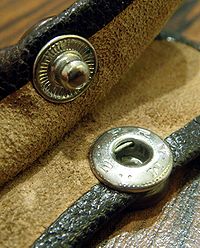
Snap fastener
Encyclopedia

Clothing
Clothing refers to any covering for the human body that is worn. The wearing of clothing is exclusively a human characteristic and is a feature of nearly all human societies...
. A circular lip under one disc fits into a groove on the top of the other, holding them fast until a certain amount of force is applied. Snap fasteners are often used in children's clothing, as they are relatively easy for children to use.
Snaps can be attached to fabric by hammering (using a specific punch and die set), plying, or sewing. For plying snap fasteners, there are special snap pliers.
In the famous Chinese Terracotta Army
Terracotta Army
The Terracotta Army or the "Terra Cotta Warriors and Horses", is a collection of terracotta sculptures depicting the armies of Qin Shi Huang, the first Emperor of China...
, dating from 210 BCE, the horse halter
Halter
A halter, headcollar, or, less often, headstall, is headgear that is used to lead or tie up livestock and, occasionally, other animals; it fits behind the ears , and around the muzzle. To handle the animal, usually a lead rope or lead shank is attached...
s of wagons, made of a gold tube and a silver tube, were joined with a form of snap fasteners. [citation needed]
Snap fasteners were first patented by German inventor Heribert Bauer in 1885 as the "Federknopf-Verschluss", a novelty fastener for men's trousers. Some attribute the invention to Bertel Sanders, of Denmark. These first versions featured an S-shaped spring in the top disc instead of a groove. However, it wasn't until Jack Weil (1901-2008) modified the design and put snaps on his iconic Western shirts that the term "Snap" became commonplace and that snaps became of feature of much Western Wear.

